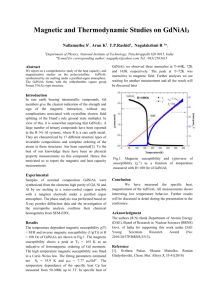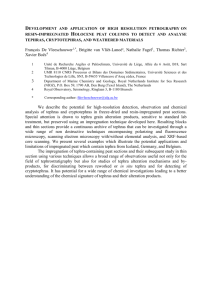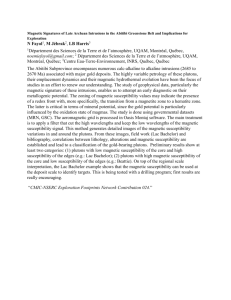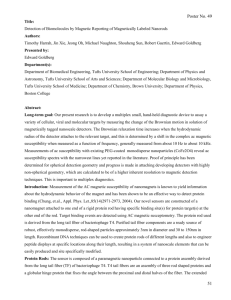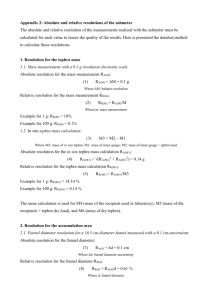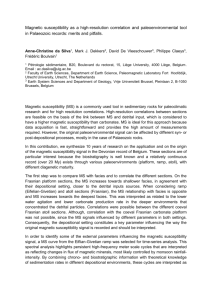View/Open - Earth-Prints Repository
advertisement
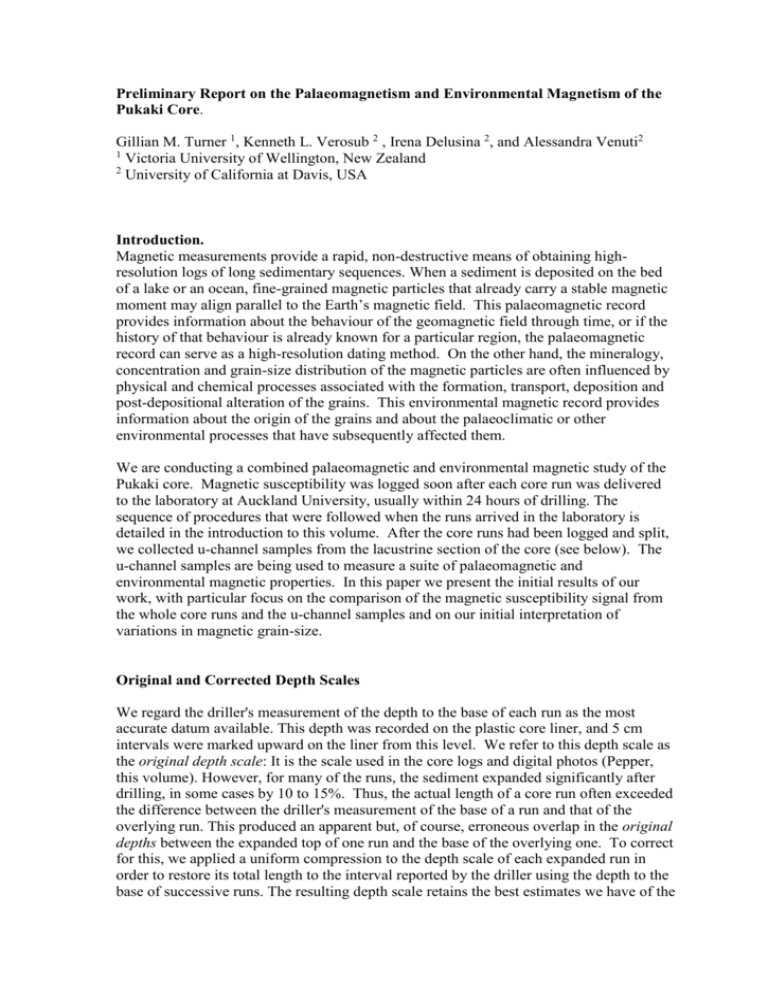
Preliminary Report on the Palaeomagnetism and Environmental Magnetism of the Pukaki Core. Gillian M. Turner 1, Kenneth L. Verosub 2 , Irena Delusina 2, and Alessandra Venuti2 1 Victoria University of Wellington, New Zealand 2 University of California at Davis, USA Introduction. Magnetic measurements provide a rapid, non-destructive means of obtaining highresolution logs of long sedimentary sequences. When a sediment is deposited on the bed of a lake or an ocean, fine-grained magnetic particles that already carry a stable magnetic moment may align parallel to the Earth’s magnetic field. This palaeomagnetic record provides information about the behaviour of the geomagnetic field through time, or if the history of that behaviour is already known for a particular region, the palaeomagnetic record can serve as a high-resolution dating method. On the other hand, the mineralogy, concentration and grain-size distribution of the magnetic particles are often influenced by physical and chemical processes associated with the formation, transport, deposition and post-depositional alteration of the grains. This environmental magnetic record provides information about the origin of the grains and about the palaeoclimatic or other environmental processes that have subsequently affected them. We are conducting a combined palaeomagnetic and environmental magnetic study of the Pukaki core. Magnetic susceptibility was logged soon after each core run was delivered to the laboratory at Auckland University, usually within 24 hours of drilling. The sequence of procedures that were followed when the runs arrived in the laboratory is detailed in the introduction to this volume. After the core runs had been logged and split, we collected u-channel samples from the lacustrine section of the core (see below). The u-channel samples are being used to measure a suite of palaeomagnetic and environmental magnetic properties. In this paper we present the initial results of our work, with particular focus on the comparison of the magnetic susceptibility signal from the whole core runs and the u-channel samples and on our initial interpretation of variations in magnetic grain-size. Original and Corrected Depth Scales We regard the driller's measurement of the depth to the base of each run as the most accurate datum available. This depth was recorded on the plastic core liner, and 5 cm intervals were marked upward on the liner from this level. We refer to this depth scale as the original depth scale: It is the scale used in the core logs and digital photos (Pepper, this volume). However, for many of the runs, the sediment expanded significantly after drilling, in some cases by 10 to 15%. Thus, the actual length of a core run often exceeded the difference between the driller's measurement of the base of a run and that of the overlying run. This produced an apparent but, of course, erroneous overlap in the original depths between the expanded top of one run and the base of the overlying one. To correct for this, we applied a uniform compression to the depth scale of each expanded run in order to restore its total length to the interval reported by the driller using the depth to the base of successive runs. The resulting depth scale retains the best estimates we have of the overall depth of each run, namely, the driller's depth to the base of the run, but restores all horizons to their correct sequence. This scale will be called the corrected depth scale. Whole Core Magnetic Susceptibility Scanning. Magnetic susceptibility was measured by passing whole core runs, enclosed in split PVC core liners, through a 100mm diameter loop sensor connected to a Bartington MS2 susceptibility meter. The meter was controlled from a PC, which also logged and displayed the data. Measurements were made at intervals of 5cm, and drift corrections applied to each core run. These corrections were kept to a minimum (1-2%) by ensuring that the meter was equilibrated to room temperature before beginning measurements and that temperature variations during measurement were small. U-Channel Sampling Following the whole-core susceptibility logging, each core run was split in half lengthwise, using non-magnetic, nylon thread. One half was photographed using the DMT Core Scan Color unit and logged in detail (Pepper). This half subsequently became the archive half, while the other was sampled for a variety of measurements. Before wrapping of the archive half, u -channel samples were taken from the lacustrine sediments (runs 32 – 49). A u-channel is a long plastic channel with a square (2.5 cm x 2.5 cm) cross section and a length of 1.5 meters. If necessary, the u-channel was cut to the length of a core run, and then inverted and pushed into the flat face of the split core. Mono-filament fishing line was then looped around the U-channel and used to free the u-channel and its sediment from the rest of the core. A cap, 2.5 cm wide and as long as the u-channel, was then snapped onto the u-channel, and the ends were sealed to minimise desiccation. The uchannels were transported to the University of California at Davis, where a series of palaeomagnetic and environmental magnetic measurements were made at 1cm intervals. Measurements of the demagnetization behaviour of different types of remanent magnetization were made on the sealed u-channels, using an automated 2G Enterprises Model 755R cryogenic magnetometer system. Meaurements of magnetic susceptibility were made using a Bartington susceptibility meter and a field surface probe. Results and Discussion Whole-core susceptibility data from the entire Pukaki core are shown in Figure 1, and on an expanded scale for the lacustrine sediments (ca 45 – 75 m) in Figure 2. In Figure 1 the original depth scale is used, while Figure 2 shows the corrected depth scale. In the marine sediments, above 47 m, the signal varies smoothly between about 10 and 20 x 10-6 SI units1, rising steeply to 100 x 10-6 SI at 10m before falling sharply in the uppermost (albeit sparsely sampled) part of the core. The peak at 10 m does not correspond to any visible change in lithology. In the lacustrine sediments the susceptibility is much more variable, with two very active intervals between ca. 53 and 59 m and ca. 63 and 69 m, 1 Susceptibility is defined as the ratio of an induced magnetization (m) to the intensity of the magnetic field (H) in which it is induced. In the SI system, the units of both M and H are A.m-1. The SI unit of susceptibility is therefore dimensionless. where the susceptibilities peak at >150 x 10-6 SI and >300 x 10-6 SI, respectively. In the flanking and intervening quieter intervals, the susceptibility does not rise above 50 x 10-6 SI. At the base of the core, below 73m, the susceptibility is high, averaging 200 x 10-6 SI, and extremely variable. This basal interval has been interpreted as comprising volcanic ejecta from the crater itself or a nearby one (Shulmeister, pers.comm.). In Figure 3, the u-channel susceptibility is shown on the original depth scale. This susceptibility, the intensity of natural remanent magnetization (NRM) and the intensity of anhysteretic remanent magnetization (ARM) are plotted on the corrected depth scale in Figure 4. There is greater detail in the u-channel measurements than in the whole core measurements because the latter were made at a wider sampling interval (i.e., 5 cm) and because the whole core sensor integrates over a length interval approximately equal to the width of the core (i.e. 10 cm). Nevertheless, the agreement between the whole core susceptibility measurements at 5 cm intervals (Figure 1) and the u-channel measurements at 1 cm intervals (Figure 3) is striking and gives confidence in the procedures used. The prominent peaks in the record of Figure 3 have been numbered 1 – 67, to facilitate reference to them (Table 1). These features vary enormously in magnitude and width. Many correlate with probable or possible basaltic or andesitic tephra noted in the core log, some of which are a millimetre or less in thickness. Other susceptibility features do not correspond to any logged sedimentological features or changes. Most rhyolitic tephra (e.g. the major Kawakawa at 54.87 m and Rotoehu at 62.90 - 64.35 m) do not produce any signature in the susceptibility record. One possible explanation is that the magnetic component of these tephra did not reach the Pukaki maar from the source area. Alternatively, the rhyolitic tephra might have lacked a significant magnetic component when they were erupted.] Susceptibility, NRM intensity and ARM intensity (Figure 4) are all measures of the concentration of magnetic material in the sediment. However they differ in the manner in which they depend on the different parts of the (magnetic) grain size spectrum. Whereas all magnetic grains (ferrimagnetic, and also superparamagnetic and to a lesser extent, paramagnetic) contribute to susceptibility, only those ferrimagnetic grains capable of retaining a stable magnetic moment contribute to the natural remanent magnetizations (NRM) and anhysteretic remanent magnetization (ARM). In a sediment, the NRM originates during the depositional and early post-depositional processes, but may subsequently be altered by diagenetic and other secondary events. Thus, the NRM may end up reflecting contributions from several different magnetic components. An ARM, on the other hand, is an artificial, laboratory-produced remanence, induced in such a way as to enhance the contribution of very fine single domain grains (~1 micron). Most of these major features of the susceptibility record, which indicate peaks in the overall concentration of magnetic material, are mirrored in the NRM and ARM records. However, the details of the NRM and ARM records differ significantly from the susceptibility record. For example, the highest susceptibility values in the lacustrine sediments (47 – 73 m) occur in the lower of the two active intervals, between 63 and 69 m, which is immediately below the Rotoehu tephra. However, the highest NRM and ARM values occur in the upper of the active intervals, with only modest values just below the Rotoehu tephra. This indicates that the overall concentration of magnetic material became high and variable in the upper interval and that there was a relative increase in finer magnetic grains Conversely, in the lower active interval, the increase in magnetic concentration principally involved coarser magnetic grains, less capable of carrying a remanence. Also, in the uppermost quiet interval defined on the basis of susceptibility (47 – 54 m), NRM and ARM values are high between 54 and 50 m. This suggests that the fine grained, remanence-bearing component remains significant up to 50 m. Two other ways of examining magnetic grain-size are shown in Figure 5. On the left is a plot of the ratio of ARM magnetization to susceptibility. This ratio is a proxy for finegrained to total magnetic material, and in some cases it may reflect trends in the grain size of the bulk (non-magnetic) sediment. Although some of the peaks of Figure 4(a) can still be discerned, the overall trend is for low values down to 50 m where there is a sharp increase. This is followed by a gradual decrease to ca. 57m, below which the values are more or less constant. On the right of Figure 5 is a plot of the ratio of ARM remaining after (alternating field) demagnetization at 20 mT to total ARM. This ratio compares the ARM carried by the grains with coercivities above 20 mT (i.e. the more stable grains) to the total ARM. The overall trend here is a steady decrease from a value of about 0.8 at 50m to 0.4 at 66m. In other words, at 50m, the magnetization is significantly “harder” than it is at 66m, which is consistent with downcore coarsening of the magnetic grains. The principal source of the magnetic minerals in the lake sediment is assumed to be local basaltic eruptions, blown into the crater, or material eroded from the crater walls. Prior to the breaching of the crater wall by the sea ca. 7000 years ago, the catchment area of the palaeo-lake was confined to the crater rim itself. Our tentative interpretation of the magnetic results is that the quiet intervals reflect periods when the sediment accumulating in the basin was derived primarily from the crater rim and that the active (magnetic) intervals correspond to periods of active volcanism within the Auckland volcanic field. The overall fining-up trend of the magnetic grains may reflect movement of the locus of volcanic activity away from immediate vicinity of the Pukaki maar. Table 1: Prominent magnetic susceptibility features in the lacustrine part of the Pukaki core, their original and corrected depths and corresponding features noted in the lithological core logs. Susceptibility Feature 1 2 3 4 5 6 7 8a 8 9 10 Core Run 33 34 34 34 35 35 35 35 35 36 36 Depth (original) Depth (corrected) 51.25 51.64 – 51.67 51.77 52.31 52.98 – 53.01 53.71 53.83, 53.88 54.16 54.315 54.57 – 54.67 54.83, 54.88, 54.98 51.25 51.77 – 51.80 51.89 52.38 53.12 – 53.15 53.78 53.89, 53.94 54.19 54.32 54.65 – 54.75 54.89, 54.94, 55.03 11 12 13 14 15 16 36 36 36 36 36 36-37 55.23 55.36 55.40 55.59 55.65 36/55.73 – 37/55.92 55.27 55.40 55.44 55.61 55.67 36/55.74 – 37/56.09 17 18 19 20 21 22 23 24 25 26 27 28 29 30a 30b 30 31 32 33 34 35 36 37 38 39 40 41 42 43 44 45 37 37 37 37 37 37 38 38 38 38 38 38 38 39 39 39 39 39 39 39 40 40 40 40 41 41 41 41 42 42 43 56.04 - 56.29 56.61 - 56.63 56.70 56.85 - 56.86 56.91 - 57.03 57.11 57.74 57.94 58.03 58.13 58.38 58.64 58.80 59.07 59.20 59.38 59.48 59.62 - 59.65 59.79 - 59.86 60.06 61.06 61.43 61.57 61.65 61.46 - 61.54 61.70 - 61.76 62.37 62.48 63.25 63.66 - 63.88 64.10 56.20 - 56.42 56.70 - 56.72 56.79 56.92 - 56.93 56.97 - 57.08 57.15 57.83 58.01 58.10 58.19 58.43 58.66 58.81 59.17 59.29 59.46 59.55 59.69 - 59.71 59.84 - 59.91 60.09 61.14 61.48 61.60 61.68 61.97 - 62.02 62.13 - 62.17 62.58 62.65 63.25 63.66 - 63.88 64.68 Core log notes 2mm dark grey band 2mm dark tephra small lenses of coarse white tephra nothing noted nothing noted, within massive clay 2cm dark grey silt ?tephra 1cm white silt ?tephra nothing noted 5cm basaltic tephra, not sampled in U-channel basaltic tephra in disturbed sediment 5mm reddish grey tephra, 1cm light grey graded tephra (?Kawakawa), nothing noted grey fine sand, basaltic/and tephra? fine black sand, basaltic tephra? 1cm very dark grey basaltic tephra ?? top of tephra 2 black basaltic tephra, with distinct transition at 36/55.82 graded unit ? tephra base of norm. graded v. dk. grey unit ? tephra base of norm. graded v. dk. grey unit ? tephra base of norm. graded v. dk. grey unit ? tephra base of norm. graded v. dk. grey unit ? tephra base of norm. graded v. dk. grey unit ? tephra sharp colour change at susc. rise above 23 sharp colour change at susc. drop below 24 3mm black sandy ? tephra 5mm layer black sandy ? tephra 2mm layer black sandy ? tephra 8-10mm thick black ? tephra 2-3mm thick ? tephra 15mm thick dk grey sandy silt ? tephra black graded unit ? tephra sharp peak, no visible marker run 40 contains many small sharp susceptibility peaks. Log shows several black (basaltic) and some lighter rhyolitic tephra: it is difficult to correlate tephra with susceptibility 4mm v. dk grey layer 20mm v. dk grey layer within disturbed Rotoehu tephra within disturbed Rotoehu tephra highest susceptibility values in core, but no 46 47 48 49 50 51 52 43 43 43 43 43 44 44 64.19 64.31 64.44, 64.51 64.67 - 64.93 65.03 - 65.23 65.67 65.78 64.74 64.81 64.89, 64.93 65.03 - 65.19 65.25 - 65.38 65.67 65.78 53 54 55 56 57 58 59 60 61 61a 62 44 44 44 44 45 45 45 46 46 46 46 66.03 66.17 - 66.20 66.29 – 66.31 66.615 66.77 67.45 68.07 68.62 68.88 68.97 69.52 66.03 66.17 - 66.20 66.29 – 66.31 66.62 66.93 67.53 68.09 68.75 68.97 69.05 69.54 63 64 65 66 67 47 47 49 49 49 70.58, 70.65 70.99 72.43 72.56 73.24 – 73.35 70.58, 70.65 70.99 72.81 72.91 73.43 – 73.51 visible markers: "slightly silty clay, v. dk grey" high susceptibilities correspond to "massive silts" between intervals of laminated clays high susceptibilities between 51 and 52 correspond to a massive v.fine mud between two laminated silty clays base of dk olive grey graded deposit possible tephra layer between 2 disturbed ints top of reverse graded unit, possible bas. teph. (VUW log only) normal graded basaltic tephra ?? ?? black basaltic tephra black basaltic tephra + graded grey tephra 1mm lt.red brown tehpra + basaltic tephra pod 3mm basaltic tephra. VUW log also shows lower peak corresponding to basaltic tephra logged at 69.64 and 69.66m log records only massive silty clay, with minor mottling log depths inconsistent: please check banded clays/fine sands => marked susceptibility activity. Figure Captions Figure 1. Whole core magnetic susceptibility, against original depth, measured at 5 cm intervals on core runs as they were received at the core logging laboratory, prior to splitting and logging. See text for discussion of the original and corrected depth scales. Positions of important tephra and stratigraphic intervals of marine and lacustrine sediments and basal volcanic ejecta are shown. Figure 2. Whole core magnetic susceptibility logs of Figure 1 for the lacustrine sediments, plotted against corrected depth. The numbered features of the magnetic susceptibility signal correspond to those identified on the more detailed record of Figure 3. Figure 3. Magnetic Susceptibility measurements made at 1 cm intervals on U-Channel samples, plotted against original depth scale. See Table 1 for details of the numbered susceptibility features, and lithological features to which they correspond. Figure 4. Logs of (a) susceptibility, (b) intensity of natural remanent magnetization (NRM) and (c) intensity of anhysteretic remanent magnetization (ARM) against corrected depth , for the lacustrine part of the core. Measurements were made at 1cm intervals, on the U-channel samples at University of California at Davis. See the text for a discussion of the comparison of these records. Figure 5. Logs of some ratios of concentration-dependent magnetic parameters. (a) ARM/susceptibility may be interpreted as a proxy for fine to coarse magnetic grain-size. (b) ARM (AF demagnetized at 20 mT)/initial ARM indicates the stable to total remanent bearing fraction. Six-order polynomial lines have been added to indicate the long-term trends in each ratio.

